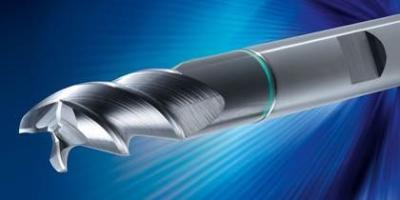
The Hoffmann Group offers a universal milling cutter for cutting steel from the MasterSteel product range. The GARANT MasterSteel PickPocket is for all milling disciplines. The tool is suitable for milling slots and pockets, as well as for side milling. However, its maneuverability for ramping and helical milling makes it particularly impressive. This all-rounder even achieves outstanding performance for drilling. The GARANT MasterSteel PickPocket is therefore suitable for anyone who is looking for a flexible solution for a range of tasks with a single solid-carbide mill.
The new GARANT MasterSteel PickPocket features an innovative front cutter geometry with three cutting edges and a drill tip recessed towards the milling shaft. The concept with three cutting edges enables large flutes in comparison with a classic four-cutter design, which is why swarf can be routed away better. This makes the tool an excellent match for aggressive ramping and plunging.
The outstanding smooth cutting action and stability of the tool are due to the unevenly spaced end face and a dynamic helical pitch, together with a special core diameter increase. The crescent shape of the end face makes the cutting edges particularly robust for plunging and ramping. At the same time, the positive rake of the solid carbide mill makes it very free-cutting and therefore ideally suited for machining fragile and thin-walled components.
The GARANT MasterSteel PickPocket is available for a diameter of 5.7 to 20 millimeters in the standard length.
Contact Details
Related Glossary Terms
- flutes
flutes
Grooves and spaces in the body of a tool that permit chip removal from, and cutting-fluid application to, the point of cut.
- gang cutting ( milling)
gang cutting ( milling)
Machining with several cutters mounted on a single arbor, generally for simultaneous cutting.
- milling
milling
Machining operation in which metal or other material is removed by applying power to a rotating cutter. In vertical milling, the cutting tool is mounted vertically on the spindle. In horizontal milling, the cutting tool is mounted horizontally, either directly on the spindle or on an arbor. Horizontal milling is further broken down into conventional milling, where the cutter rotates opposite the direction of feed, or “up” into the workpiece; and climb milling, where the cutter rotates in the direction of feed, or “down” into the workpiece. Milling operations include plane or surface milling, endmilling, facemilling, angle milling, form milling and profiling.
- milling cutter
milling cutter
Loosely, any milling tool. Horizontal cutters take the form of plain milling cutters, plain spiral-tooth cutters, helical cutters, side-milling cutters, staggered-tooth side-milling cutters, facemilling cutters, angular cutters, double-angle cutters, convex and concave form-milling cutters, straddle-sprocket cutters, spur-gear cutters, corner-rounding cutters and slitting saws. Vertical cutters use shank-mounted cutting tools, including endmills, T-slot cutters, Woodruff keyseat cutters and dovetail cutters; these may also be used on horizontal mills. See milling.
- milling machine ( mill)
milling machine ( mill)
Runs endmills and arbor-mounted milling cutters. Features include a head with a spindle that drives the cutters; a column, knee and table that provide motion in the three Cartesian axes; and a base that supports the components and houses the cutting-fluid pump and reservoir. The work is mounted on the table and fed into the rotating cutter or endmill to accomplish the milling steps; vertical milling machines also feed endmills into the work by means of a spindle-mounted quill. Models range from small manual machines to big bed-type and duplex mills. All take one of three basic forms: vertical, horizontal or convertible horizontal/vertical. Vertical machines may be knee-type (the table is mounted on a knee that can be elevated) or bed-type (the table is securely supported and only moves horizontally). In general, horizontal machines are bigger and more powerful, while vertical machines are lighter but more versatile and easier to set up and operate.
- pitch
pitch
1. On a saw blade, the number of teeth per inch. 2. In threading, the number of threads per inch.
- rake
rake
Angle of inclination between the face of the cutting tool and the workpiece. If the face of the tool lies in a plane through the axis of the workpiece, the tool is said to have a neutral, or zero, rake. If the inclination of the tool face makes the cutting edge more acute than when the rake angle is zero, the rake is positive. If the inclination of the tool face makes the cutting edge less acute or more blunt than when the rake angle is zero, the rake is negative.
- swarf
swarf
Metal fines and grinding wheel particles generated during grinding.
